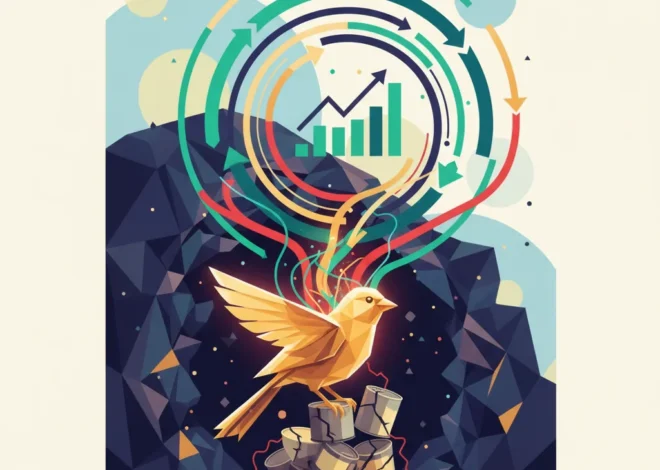
The Fed’s Cold Feet: Why Wall Street is Suddenly Ditching Rate Cut Bets
Just a few short months ago, the narrative on Wall Street seemed set in stone. The Federal Reserve, after a historic and aggressive hiking cycle, was finally ready to pivot. Investors, traders, and financial institutions were pricing in a series of interest rate cuts, with the champagne all but on ice for a December easing. But in the world of finance and economics, certainty is a luxury, and the script has been dramatically flipped. The chorus of confident predictions has faded into a murmur of anxious whispers as stubborn inflation data and a visibly divided Federal Reserve have forced a market-wide reality check.
The change has been swift and severe. Market expectations for a rate cut in December have plummeted, with the probability now seen as almost half of what it was just weeks ago, according to data tracking futures markets. This sharp reversal isn’t just a minor adjustment; it’s a fundamental reassessment of the U.S. economy’s trajectory and the central bank’s resolve. For investors, business leaders, and anyone with a stake in the stock market, understanding this shift is critical. The era of “easy money” isn’t returning as quickly as hoped, and the implications for everything from corporate earnings to personal investing strategies are profound.
The Inflation Ghost That Won’t Be Busted
The primary culprit behind this market whiplash is a familiar foe: inflation. While headline inflation has cooled significantly from its multi-decade peaks, the devil is in the details. Policymakers are increasingly focused on “sticky” components of inflation, particularly in the services sector, which are proving difficult to tame. Recent Consumer Price Index (CPI) reports have shown that while goods prices have stabilized, costs for services like housing, transportation, and healthcare continue to climb at an uncomfortable pace.
This persistence is forcing the Federal Reserve to confront a difficult truth: their battle is not yet won. The “last mile” of getting inflation back to their 2% target is proving to be the hardest. A premature rate cut could reignite inflationary pressures, undoing all the painful work of the past two years and severely damaging the Fed’s credibility. This concern was echoed in recent statements from several Fed officials who have emphasized a “higher for longer” stance, signaling that the current restrictive policy needs more time to work its way through the economy.
The market is finally listening. The odds of a December rate cut, which stood at over 60% a month ago, have now fallen to just over 30% (source). This repricing reflects a growing consensus that the Fed will prioritize vanquishing inflation over providing a short-term boost to the stock market or the broader economy.
A House Divided: The Hawks and Doves of the FOMC
Adding another layer of complexity is the increasingly public schism within the Federal Open Market Committee (FOMC), the body responsible for setting interest rates. The committee is broadly divided into two camps: the “hawks” and the “doves.”
- Hawks: These members are primarily concerned with inflation. They advocate for maintaining high interest rates—or even hiking them further—to ensure price pressures are fully extinguished. They are willing to risk a slowdown in economic growth to achieve their inflation target.
- Doves: These members are more concerned with the Fed’s dual mandate, which includes maximizing employment. They worry that keeping rates too high for too long could trigger an unnecessary recession and significant job losses. They are generally more inclined to cut rates sooner to support the economy.
This internal debate, once confined to closed-door meetings, is now playing out in public speeches and interviews, creating a confusing and often contradictory stream of signals for the market. One day, a hawkish governor might warn about the “significant upside risks to inflation,” while the next, a dovish president could highlight the “cooling labor market” as a reason for patience. This divergence is a key reason for the recent volatility in the trading world, as investors struggle to discern the true consensus of the committee.
To illustrate the differing perspectives, consider the current arguments from both sides:
| Viewpoint | The ‘Hawk’ Argument (Pro-Higher Rates) | The ‘Dove’ Argument (Pro-Patience/Cuts) |
|---|---|---|
| On Inflation | Core services inflation remains stubbornly high. A premature pivot could lead to a 1970s-style resurgence. | Lagging indicators like shelter costs are distorting the data. Leading indicators show significant disinflation ahead. |
| On the Labor Market | The labor market is still too tight, with wage growth that is inconsistent with a 2% inflation target. | Job openings are declining and quit rates are normalizing. The risk of a sharp rise in unemployment is growing. |
| On Financial Conditions | Conditions are not yet restrictive enough to guarantee a return to price stability, as evidenced by strong stock market performance. | The full impact of past rate hikes has yet to be felt. Further tightening risks a credit crunch and financial instability. |
The Ripple Effect: What a Hawkish Fed Means for Your Investments
The shift in rate cut expectations is not an academic exercise; it has tangible consequences for every corner of the financial world, from global banking to individual investing portfolios.
Stock Market Turbulence: The prospect of “higher for longer” interest rates is generally a headwind for equities. Higher rates make borrowing more expensive for companies, potentially squeezing profit margins. They also increase the appeal of safer assets like bonds, which offer higher yields, drawing money away from the stock market. Growth-oriented sectors, particularly in financial technology and tech, are especially vulnerable as their valuations are often based on future earnings, which are discounted more heavily when rates are high.
Bond Market Re-evaluation: For bond investors, the equation is more direct. When the market expects the Fed to keep rates high, bond yields rise to reflect that expectation. This means the price of existing bonds with lower yields falls. Investors who have been betting on a swift Fed pivot to cuts have seen significant unrealized losses in their bond portfolios.
The Fintech and Banking Sector: The financial technology (fintech) and traditional banking sectors face a mixed bag. Higher rates can boost net interest margins for banks, as they can charge more for loans. However, it can also stifle loan demand and increase the risk of defaults. For fintech startups, many of which are not yet profitable, a high-rate environment makes access to venture capital and funding more difficult and expensive, potentially slowing innovation.
The Global Economy and Blockchain: A hawkish Fed typically means a stronger U.S. dollar, which can create headwinds for emerging markets that have dollar-denominated debt. In the world of digital assets, the narrative is complex. Some proponents argue that assets like Bitcoin, operating on a decentralized blockchain, can act as a hedge against traditional monetary policy missteps. However, in practice, these assets have often traded like high-risk tech stocks, suffering when liquidity is withdrawn from the system by central banks. Their role in this specific economic environment remains a subject of intense debate.
The Bouzouki Portfolio: What a Niche Music Shop Teaches Us About Modern Investing
Navigating the New Normal: Strategies for the Modern Investor
With the path forward so uncertain, how should investors adjust their strategies? Panic is never a plan. Instead, this environment calls for discipline, diversification, and a long-term perspective.
- Re-embrace Diversification: The old rules still apply. A diversified portfolio across asset classes (stocks, bonds, real assets), geographies, and sectors can help cushion against volatility. When one area of the market is struggling, another may be thriving.
- Focus on Quality and Cash Flow: In a high-rate world, companies with strong balance sheets, consistent cash flow, and durable competitive advantages (a “moat”) tend to outperform. Speculative, high-growth companies with no clear path to profitability become far riskier propositions.
- Stay Informed, Not Obsessed: It’s essential to understand the economic forces at play. Modern financial technology and trading platforms offer incredible tools for research and analysis. However, reacting to every news headline or Fed speech is a recipe for disaster. Develop a solid investment thesis and stick to it, making only tactical adjustments as the fundamental picture changes.
- Extend Your Time Horizon: Market timing is a fool’s errand. Trying to predict the Fed’s next move is a game best left to professional traders with immense resources. For most, the best strategy is to invest for the long term, allowing time to smooth out the short-term bumps in the road. As one Fed governor noted, “Monetary policy works with long and variable lags,” a principle that applies equally well to a sound investing strategy (source).
The Great Wealth Migration: Why Chinese Fortunes Are Swapping Singapore for Dubai
The market’s abrupt U-turn on rate cuts is a powerful reminder that in economics, nothing is guaranteed. The Federal Reserve is engaged in a delicate and high-stakes balancing act, and the final chapter on this inflationary period has yet to be written. For now, the message from Wall Street is clear: the party has been postponed. Investors and business leaders must now adapt to a reality where capital is more expensive and economic uncertainty is the only sure bet.


